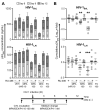The Progestin Medroxyprogesterone Acetate Affects HIV-1 Production in Human Lymphoid Tissue Explants in a Dose-Dependent and Glucocorticoid-like Fashion
- PMID: 34835109
- PMCID: PMC8621851
- DOI: 10.3390/v13112303
The Progestin Medroxyprogesterone Acetate Affects HIV-1 Production in Human Lymphoid Tissue Explants in a Dose-Dependent and Glucocorticoid-like Fashion
Abstract
The association between the use of the injectable contraceptive depot medroxyprogesterone acetate and HIV-1 susceptibility has been addressed mainly in respect to the changes occurring in the female genital mucosa and blood. However, one of the main sites of HIV-1 pathogenesis is lymphoid organs. To investigate the immunoregulatory effect of medroxyprogesterone acetate (MPA) at this site, human tonsillar tissue explants were infected ex vivo with either a CCR5 (BaL) or CXCR4 (LAI) HIV-1 variant and the release of p24gag and cytokines was measured in culture supernatant. The response to MPA was compared with that elicited by treatment with progesterone (P4) and dexamethasone (DEX), which selectively binds the glucocorticoid receptor, in donor-matched explant cultures. MPA treatment reduced the replication of both tested HIV-1 strains as well as the production of the mediators of inflammation IL-1β, IL-17A and CCL5, but not CCL20, in a similar way to DEX, whereas P4 had no effect on HIV-1 replication. The magnitude of both MPA and DEX-mediated responses was proportional to the length of exposure and/or administered dose. Blockage of the progesterone and glucocorticoid receptors with mifepristone abolished all observed changes in HIV-1 and cytokine production, and was associated with increased IL-22 levels in HIV-infected explants. Our data indicate that elevated doses of MPA may affect the immune responses in lymphoid tissue in a glucocorticoid-like fashion with an immediate impact on local HIV-1 replication.
Keywords: DMPA; HIV-1; cytokines; glucocorticoids; hormonal contraception; lymphoid tissue; progesterone; sex hormones; tissue explants; tonsils.
Conflict of interest statement
The authors declare no conflict of interest. The funders had no role in the design of the study; in the collection, analyses, or interpretation of data; in the writing of the manuscript, or in the decision to publish the results.
Figures




References
-
- Population Division, Department of Economic and Social Affairs, United Nations Contraceptive Use by Method 2019: Data Booklet (ST/ESA/SER.A/435) 2019. [(accessed on 11 November 2021)]. Available online: https://www.un.org/en/development/desa/population/publications/pdf/famil....
-
- Heffron R., Achilles S.L., Dorflinger L.J., Hapgood J.P., Kiarie J., Polis C.B., Steyn P.S. Pharmacokinetic, biologic and epidemiologic differences in MPA- and NET-based progestin-only injectable contraceptives relative to the potential impact on HIV acquisition in women. Contraception. 2019;99:199–204. doi: 10.1016/j.contraception.2018.12.001. - DOI - PMC - PubMed
-
- Evidence for Contraceptive Options and HIV Outcomes (ECHO) Trial Consortium HIV incidence among women using intramuscular depot medroxyprogesterone acetate, a copper intrauterine device, or a levonorgestrel implant for contraception: A randomised, multicentre, open-label trial. Lancet. 2019;394:303–313. doi: 10.1016/S0140-6736(19)31288-7. - DOI - PMC - PubMed

